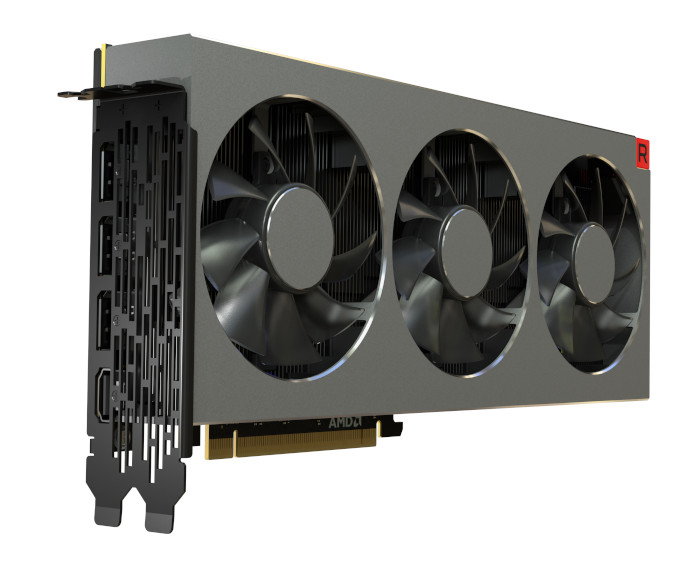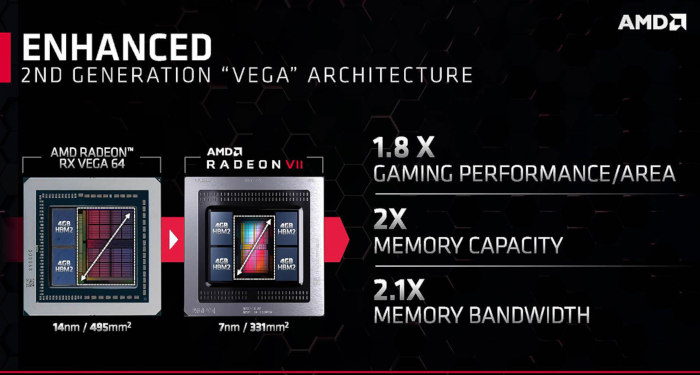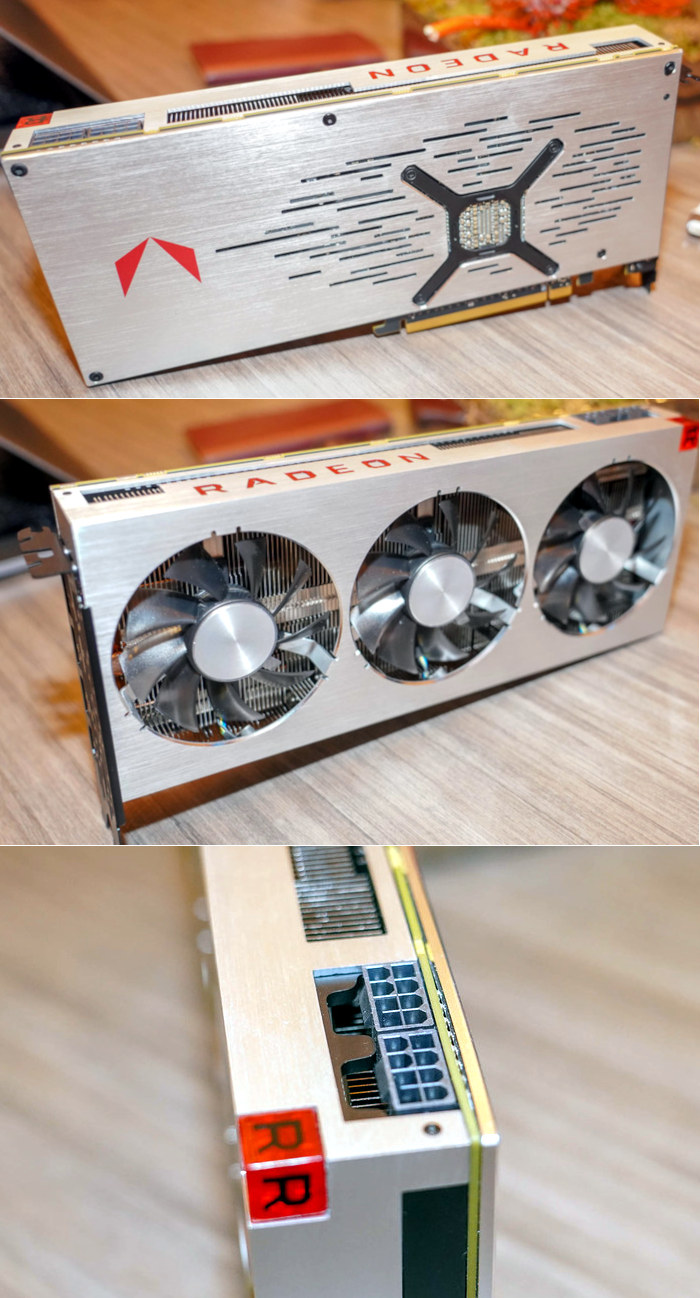
CES: AMD Reveals 7nm AMD Radeon VII Graphics Card, Demonstrates Upcoming 3rd Gen AMD Ryzen Desktop Processor
AMD today highlighted annnounced at CES the first 7nm gaming graphics processing unit, AMD Radeon VII; detailed the 2nd Gen AMD Ryzen Mobile processors and provided the first public demonstration of the upcoming 7nm 3rd Gen AMD Ryzen desktop processor.
AMD President and CEO Dr. Lisa Su was joined by a number of industry luminaries including Microsoft Executive Vice President of Gaming Phil Spencer, Massive Entertainment Managing Director David Polfeldt, and FNATIC Co-Founder and Chairman Sam Mathews.
“This is an incredible time to be in technology as the industry pushes the envelope on high-performance computing to solve the biggest challenges we face together,” said Su. “At AMD, we made big bets several years ago to accelerate the pace of innovation for high-performance computing, and 2019 will be an inflection point for the industry as we bring these new products to market. From our 7nm Radeon graphics chips to our next-generation 7nm AMD Ryzen™ and AMD EYPC processors, it’s going to be an exciting year for AMD and the industry.”
Indeed, with 7nm silicon available next month, AMD will beat both Intel and Nvidia to the most advanced technology node.
AMD Gaming Graphics Updates
AMD announced the world’s first 7nm gaming GPU, AMD Radeon VII, designed to deliver exceptional performance and amazing experiences for the latest AAA, esports and Virtual Reality (VR) titles, demanding 3D rendering and video editing applications, and next-generation compute workloads.

AMD says that the Radeon VII graphics card provides 2x the memory and 2.1x the memory bandwidth, up to 29 percent higher gaming performance on average and up to 36 percent higher performance on average in content creation applications compared to the AMD Radeon RX Vega 64 graphics card. It also provides high-refresh HDR gaming at 1080p, ultrawide 1440p and 4K, and powers the next-generation photo and visual creation applications on 8K monitors.
The Alienware Area 51 2nd Generation Threadripper Edition will now combine the new AMD Radeon VII graphics cards with 2nd Generation AMD Ryzen Threadripper processors. Also, the professional esports gaming team, Fnatic, will use AMD Radeon VII graphics cards in its high-performance gaming PCs for training and online competitions.



In addition, Ubisoft plans to bring AMD Radeon technologies to its upcoming AAA blockbuster, Tom Clancy’s The Division 2. The Division 2 will support the features gamers demand including DirectX 12 and support for AMD Radeon FreeSync 2 HDR technology, as well as technologies such as shader intrinsics, rapid packed math, and asynchronous compute.

| AMD Radeon VII | AMD Radeon RX Vega 64 | |
| Stream Processors | 3840 (60 CUs) |
4096 (64 CUs) |
| ROPs | 128 | 64 |
| Base Clock | ? | 1247MHz |
| Boost Clock | 1800MHz | 1546MHz |
| Memory Clock | 2.0Gbps HBM2 | 1.89Gbps HBM2 |
| Memory Bus Width | 4096-bit | 2048-bit |
| VRAM | 16GB | 8GB |
| Single Precision Perf. | 13.8 TFLOPS | 12.7 TFLOPS |
| Board Power | 300W? | 295W |
| Manufacturing Process | TSMC 7nm | GloFo 14nm |
| GPU | Vega 20 | Vega 10 |
| Architecture | Vega (GCN 5) |
Vega (GCN 5) |
| PCIe | 4.0 x16 3.0 x16 |
3.0 x16 |
| Transistor Count | 13.2B | 12.5B |
| Price | $699 | $599 |
The Radeon VII employs a slightly cut down version of AMD’s Vega 20 GPU. With 60 of 64 CUs enabled, it actually has a few less CUs than AMD’s previous flagship, the Radeon RX Vega 64, but it makes up for the loss with much higher clockspeeds and a much more powerful memory and pixel throughput backend.

The new card has the same 60 CU configuration paired with 16GB of HBM2 memory as AMD’s second-tier Radeon Instinct MI50. However the Radeon VII’s boost clock is a bit higher – 1800MHz versus 1746MHz.
But the biggest difference between the two cards is on the memory/ROP backend. Radeon Vega 64 (Vega 10) featured 64 ROPs and 2 HBM2 memory channels running at 1.89Gbps each, for a total of 484GB/sec of memory bandwidth. Radeon VII (Vega 20) doubles this and then some to 128 ROPs and 4 HBM2 memory channels, which also means memory capacity has doubled to 16GB. On the top of this, the new card offers a clckspeed boost: 1800MHz for the ROPs, and 2.0Gbps for the HBM2 memory.
In terms of gaming, AMD says that the Radeon VII graphics card delivers up to 35 percent higher performance in Battlefield V, and up to 42 percent higher performance in Strange Brigade, compared to the AMD Radeon RX Vega 64 graphics card. It also delivers up to 25 percent higher performance in the widely popular esports title, Fortnite.
With AMDs ‘Raise the Game Fully Loaded’ bundle, AMD plans to offer gamers complimentary PC versions of the Resident Evil 2, Devil May Cry 5 and Tom Clancy’s The Division 2 with the purchase of an eligible AMD Radeon VII graphics card or Radeon VII powered PC, as well as with the purchase of other eligible Radeon graphics cards and Radeon powered PCs.
The AMD Radeon VII graphics card is expected to be available beginning February 7, 2019 for $699 SEP USD.
AMD High-Performance Desktop Updates
AMD performed the first public demonstrations of the upcoming 3rd Gen AMD Ryzen desktop processor. The 3rd Gen AMD Ryzen processor is based on the new AMD “Zen 2” x86 core built using 7nm process technology. It is expected to deliver new levels of performance and will be the first PC platform to support PCIe 4.0 connectivity.

The live demonstration showed a 8-core/16-thread 3rd Generation Ryzen desktop pre-production processor vs. an Intel Core i9-9900K processor in a real-time rendering demonstration using Maxon Cinebench R15. The AMD Ryzen processor offered comparable performance at approximately 30% lower power. The benchmark also revealed multi-threaded performance 14% faster than the Ryzen 7 2700X. However, what is clear is that core-for-core, AMD is level with Intel in terms of performance here, which points at a decent increase in IPC or frequency or both for Zen 2 CPUs. But the most impressive here were the power consumption numbers. the AMD system drew just 133W compared to 180W for the equivalent Intel system, which is likely thanks to the 7nm manufacturing process.

Su said that she wanted to establish a head-to-head comparison, using comparable core counts.
“Some people may have noticed on the package some extra room,” she said with a chuckle. “There is some extra room on that package and I think you might expect we will have more than eight cores.”
Additionally, Dr. Su showed the power of AMD technology working together with a live gaming demonstration of a 3rd Gen AMD Ryzen desktop processor in an AMD socket AM4 platform paired with an AMD Radeon VII graphics processor.
Intel has pushed hard to establish itself as the supplier of the fastest desktop processor, leaning hard on its manufacturing prowess and the fact that many games still don’t take advantage of multi-core, parallel chips.
“Our first priority is overall system performance, but we know how important single-thread performance is,” Su said. “So you will see us push single-threaded performance.”
AMD revealed today no information of frequencies, models or pricing. The 3rd Gen Ryzen desktop processor is planned for introduction in mid-2019.
AMD Server Updates
Su showed the first 7nm datacenter CPU, codenamed “Rome,” based on the “Zen 2” x86 core.

Su revealed the real-world power of the next generation of AMD EPYC by demonstrating a step-function increase in datacenter processor performance using the scientific application NAMD, which simulates large bio-molecular systems. The demonstration compared a single pre-production EPYC “Rome” processor to two high-end Intel Xeon Platinum 8180 processors, and the single next-generation EPYC processor delivered approximately 15% higher performance.
Among other things, Su said the second-generation EPYC offers four times the floating point performance and twice the computing performance per socket compared to its predecessor. "I will go so far as to say we believe it is the best server processor the world has ever seen," Su said.
The AMD EPYC “Rome” processor is on track to start shipping in mid-2019.
AMD Mobile Computing Updates
AMD launched the 2nd Gen AMD Ryzen Mobile processor with Radeon Vega Graphics, AMD's Ryzen 3000 Series, is dedigned for ultrathin laptops.
The initial 3000 Series chips feature two or four cores with eight or four threads and boost performance of up to 4.0GHz. Perhaps most notable about the Ryzen 3000 Series is that the devices enable up to 12 hours of general productivity and 10 hours of video playback battery life, 4K HDR video capability and Microsoft Modern PC features, according to AMD.

AMD Ryzen-based notebooks powered by the 2nd Gen AMD Ryzen Mobile processor with Radeon Vega Graphics are expected to be available in 2019 from Acer, Asus, Dell, HP, Huawei, Lenovo and Samsung.





















